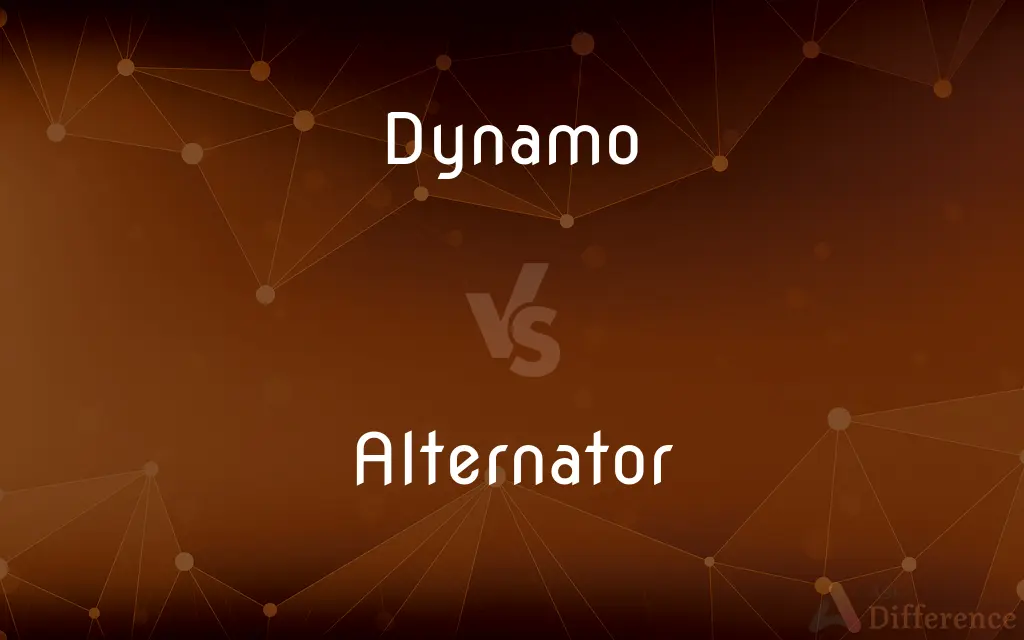Dynamo vs. Alternator — What's the Difference?
By Tayyaba Rehman — Updated on October 12, 2023
Dynamo generates DC power using mechanical movement; alternator creates AC power similarly but can be converted to DC.

Difference Between Dynamo and Alternator
Table of Contents
ADVERTISEMENT
Key Differences
The dynamo, a device that converts mechanical energy into direct current (DC) electricity, contrasts with the alternator, which generates alternating current (AC) electricity.
Generally, dynamos are known for their ability to produce a stable DC electrical output, whereas alternators tend to produce AC electrical output, widely used in automotive and industrial applications.
In a dynamo, the electrical and magnetic circuits are stationary, while in an alternator, they rotate, typically at high speeds, to facilitate the generation of electricity.
Though both dynamos and alternators are used for power generation, dynamos are largely considered obsolete due to their size and inefficiency, while alternators are preferred for their lighter weight and higher efficiency.
An inherent feature of a dynamo is its simpler construction and less requirement for additional components, while an alternator usually needs a rectifier to convert its output to DC, making it slightly complex.
ADVERTISEMENT
Comparison Chart
Type of Current
Direct Current (DC)
Alternating Current (AC)
Usage & Application
Now largely obsolete
Widely used in modern vehicles
Size & Weight
Typically larger and heavier
Compact and lightweight
Efficiency
Less efficient
More efficient
Complexity
Simpler in construction
Requires additional components like a rectifier
Compare with Definitions
Dynamo
Informally, a dynamo can refer to a highly energetic person.
With her relentless enthusiasm, she was considered a dynamo in the office.
Alternator
Alternators typically produce three-phase AC, which can be converted to DC.
The three-phase output of the alternator is converted to DC to charge the car battery.
Dynamo
A dynamo is a machine that generates direct current electrical power.
The old lighthouse used a dynamo to power its beacon.
Alternator
Alternators usually have a rotating magnetic field.
The alternator in my vehicle broke down, causing the battery to die.
Dynamo
Historically, a dynamo was used in early automotive electrical systems.
Vintage cars often feature a dynamo instead of an alternator.
Alternator
Alternators are integral in maintaining a vehicle’s electrical charge.
If the alternator fails, the car might stall due to a depleted battery.
Dynamo
Dynamo, in some contexts, might refer to a type of generator in various machinery.
The old milling machine was equipped with a reliable dynamo.
Alternator
In electricity generation, an alternator can be a major component in power plants.
The power plant utilizes a large alternator to generate electricity for the grid.
Dynamo
In cycling, a dynamo can refer to a device providing power to lights.
He connected a dynamo to his bicycle to ensure he had light on night rides.
Alternator
An alternator is a device that converts mechanical energy to alternating current electrical energy.
Modern cars use an alternator to charge the battery and power the electrical system.
Dynamo
A dynamo is an electrical generator that creates direct current using a commutator. Dynamos were the first electrical generators capable of delivering power for industry, and the foundation upon which many other later electric-power conversion devices were based, including the electric motor, the alternating-current alternator, and the rotary converter.
Alternator
An alternator is an electrical generator that converts mechanical energy to electrical energy in the form of alternating current. For reasons of cost and simplicity, most alternators use a rotating magnetic field with a stationary armature.
Dynamo
A generator, especially one for producing direct current.
Alternator
An electric generator that produces alternating current.
Dynamo
An extremely energetic and forceful person
A vice president who was the real dynamo of the corporation.
Alternator
(electrical engineering) An electric generator which produces alternating current through mechanical means.
Dynamo
(electromagnetism) An electricity generator; a dynamo-electric machine.
Alternator
An electric generator or dynamo for producing alternating currents.
Dynamo
(astrophysics) The mechanism by which a celestial body, such as the Earth or a star, generates a magnetic field.
Alternator
An old term for an electric generator that produces alternating current (especially in automobiles)
Dynamo
(figuratively) An energetic person.
That new Vice President of Marketing is a real dynamo; sales have already gone up this quarter.
Dynamo
A dynamo-electric machine.
Dynamo
Generator consisting of a coil (the armature) that rotates between the poles of an electromagnet (the field magnet) causing a current to flow in the armature
Common Curiosities
What distinguishes an alternator’s output?
An alternator produces alternating current (AC).
What type of current does a dynamo produce?
A dynamo produces direct current (DC).
In which applications are alternators commonly found?
Alternators are commonly found in modern vehicles and power plants.
Can a dynamo be used in a car?
Yes, but dynamos are largely replaced by alternators in modern automotive design.
Why are dynamos considered obsolete?
Dynamos are bulkier and less efficient compared to alternators.
How do alternators benefit modern vehicles?
Alternators are lighter, more efficient, and produce AC, suitable for modern vehicle electrical systems.
What's a notable downside of using a dynamo?
Dynamos are heavier and typically generate less power than alternators.
Can a dynamo be used to power household appliances?
Yes, but its DC output can be a limiting factor for AC appliances.
Why do alternators use a rotating magnetic field?
It allows efficient generation of AC with less wear on the moving parts.
What is a notable structural difference between a dynamo and an alternator?
Dynamos have stationary electrical and magnetic circuits, while alternators have rotating ones.
Were dynamos used in early electrical systems in vehicles?
Yes, dynamos were common in early automotive electrical systems.
Is a rectifier necessary for an alternator’s operation?
Yes, to convert the AC to DC for use in vehicle systems.
Is an alternator capable of charging a battery?
Yes, alternators can charge batteries while also powering a vehicle’s electrical system.
How is a dynamo used in a bicycle system?
A bicycle dynamo generates power for lights or other small electrical accessories.
Can an alternator’s AC output be converted to DC?
Yes, through a rectifier, alternators can provide DC output suitable for charging batteries and powering DC systems.
Share Your Discovery

Previous Comparison
Society vs. Culture
Next Comparison
Pedagogy vs. AndragogyAuthor Spotlight
Written by
Tayyaba RehmanTayyaba Rehman is a distinguished writer, currently serving as a primary contributor to askdifference.com. As a researcher in semantics and etymology, Tayyaba's passion for the complexity of languages and their distinctions has found a perfect home on the platform. Tayyaba delves into the intricacies of language, distinguishing between commonly confused words and phrases, thereby providing clarity for readers worldwide.
















































